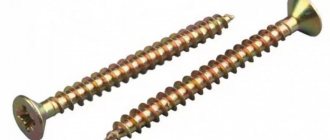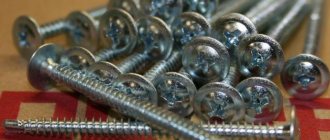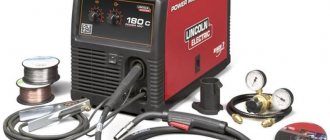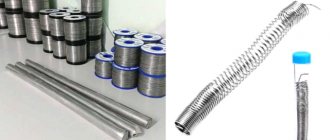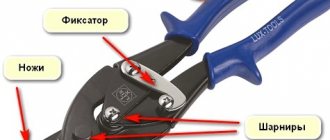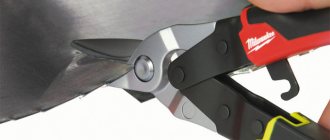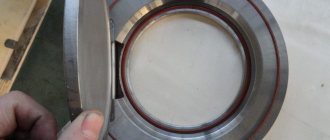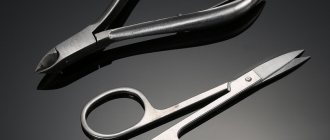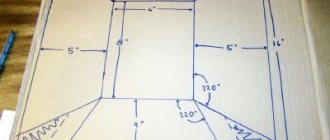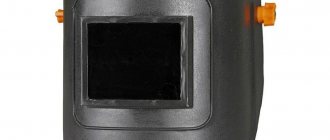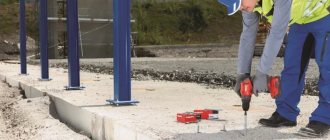A dowel for concrete is a type of fastening element. Used for insertion into vertical or horizontal cement-based structures. The concrete mass is characterized by high strength, so the fastening must withstand high loads. They are considering special fasteners that look like a self-tapping screw, but have improved characteristics.
Device
A dowel (another name is a screw) is a metal rod on which a thread is applied. On one side, the fastening element is pointed, which allows it to be inserted into a dense concrete mass. On the other side there is a head with a notch.
Hardware must withstand significant loads of torsion, compression and tension. Such properties are due to the characteristics of the metal from which concrete screws (pins) are made.
Possible options:
- carbon metal;
- stainless steel;
- brass (an alloy of copper and zinc).
The first option is characterized by strength and ductility. However, only high-alloy steels have these characteristics. They are designed for the production of structural and fastening elements that will be subject to significant loads.
Stainless steel differs from its analogues in its ability to withstand moisture. Products made from this material do not rust. They are more affordable in price when compared with some types of fasteners. Hardware is made from stainless steel containing alloying elements.
A concrete screw (nail) made of brass is characterized by high strength, but mediocre anti-corrosion properties. When environmental conditions change, the products do not become brittle, which is important for fasteners.
Despite a number of positive properties of other materials, self-tapping screws for concrete are often made from carbon steel.
What is a concrete dowel?
Such screws are most often used for fastening heavy structures - frames, door jambs, cabinets, shelves, fences, heating radiators and other communications. The screw is held tightly due to the uneven two-start thread and notches along its entire length. This shape ensures reliable fixation even in a concrete wall. On the head of the screw there are notches for countersinking.
The dowel for concrete looks like an elongated self-tapping screw with a thread in the center. On one side there is a head with a hexagonal groove, on the other side there is a sharp end. They are made from carbon steel with a protective galvanized or anodized coating, which provides protection against corrosion and other influences. For screwing, TORX T30 bits are used.
The fasteners can be reused, which is a great advantage for temporary structures. They are chosen for their low price, resistance to moisture and stress, and reliable fixation of objects, regardless of the material.
Types of hardware
Fasteners differ in color:
- black: with a protective film, the concrete screw (dowel) does not withstand direct exposure to moisture, therefore it is used only indoors with a normal level of humidity;
- yellow: yellow zinc is used in production, such screws are not intended for use outside the premises;
- silver: zinc is applied to products by galvanic means, which makes the fasteners universal.
Concrete screws (dowels) are divided into groups taking into account the differences in head shapes:
- secret;
- with a protruding head.
In the first case, it becomes possible to hide the fasteners. In this case, the self-tapping screw is completely buried in the concrete mass. The cap does not rise above the surface. Products with a protruding head remain visible when installed in concrete. Possible types of fasteners, which differ in the shape of the cap:
- hexagonal;
- conical in shape with a slot of different configurations (cross-shaped, in the form of a multifaceted asterisk).
A hairpin or self-tapping screw without a head is considered separately. A nut is loosely screwed onto such an element.
When choosing concrete screws, their dimensions are studied first:
- universal, they are characterized by a length of no more than 20 cm, cross-sectional size of no more than 6 mm;
- with inclined thread, such self-tapping screws are used only in conjunction with dowels; holes are pre-drilled for installation in a concrete mass;
- with intermittent threads, cross-sectional size - up to 7.5 mm, length varies from 7 to 20 cm, this type of product is designed to simplify the process of introducing a fastening element into concrete, but preliminary drilling of the structure is required.
Features of choosing fasteners
The main criterion for choosing a dowel for concrete is the ability of the fixing element to withstand the expected load. According to experts, for a small-sized and lightweight structure, such as a bookshelf, a screw 70 mm long is suitable. To secure a window frame or door in the opening, you will need longer dowels. Thus, a structure weighing a total of about 100 kg requires the use of screws whose length is at least 150 mm.
An important point when choosing a fastener is the step with which the element is mounted in the general installation system of one object. The distance between the screws should be about 70-100 mm. This distance is reduced or increased, depending on the structural features of the object connected to the concrete base.
When choosing fasteners for concrete, be sure to take into account operating conditions. It’s one thing to use a dowel in a room with a high level of humidity (bathroom, sanitary unit), and another thing to use in a room with dry air, so special attention is paid to the protective coating of the fasteners.
Characteristics
Main parameters of hardware:
- outer section does not exceed 7.65 mm;
- thread pitch varies from 2.5 to 2.75 mm;
- internal cross-section reaches 5.45 mm;
- head height does not exceed 3.2 mm;
- cap diameter - up to 11.82 mm;
- if there is a head, a slot is always provided;
- the length of the fastening element varies over a wide range, the upper limit of which is 184 mm;
- the hole for the screw is always smaller than the external cross-section of the fastener;
- the depth of the holes in the concrete mass is 1.5 cm greater than the length of the hardware;
- The minimum permissible distance between adjacent screws is also regulated; when installing fasteners in the most durable material (concrete), it is allowed to leave at least 3 cm between the holes.
How to screw in a self-tapping screw when installing drywall
Before you screw a self-tapping screw into drywall, you need to think about tools that can make the job easier. Let's look at what tools and devices can be used: For a repairman, screwing in self-tapping screws is something understandable that does not raise any questions. Beginners believe that attaching drywall to the frame using self-tapping screws is the easiest to repair. But not everyone knows how to screw a self-tapping screw into drywall so that there are no problems later. Errors at this stage of repair can lead to the creation of a fragile coating.
The screws must be screwed in from one edge of the sheet to the other. You cannot screw them in at random, as this can lead to deformation of the drywall. The fastening pitch ranges from 15 to 30 cm, depending on the specific situation. The screwdriver applies slight pressure on the fastener and turns on maximum speed.
This is necessary so that the screw can fit into the profile to which the gypsum board is attached. As soon as it passes into the profile, you can reduce the speed and tighten the screw slowly. If the speed is not reduced, the sheet core will be damaged. The screw should fit into the sheet so that the head sank into it by 1-2 mm.
You need to work with a screwdriver gently, without much effort at first. If the self-tapping screw has not yet begun to enter the plasterboard, then the screwdriver under pressure may jump off and pierce the surface. When the screw has entered a little into the core of the material, you can already apply more force to screw it in completely.
Additional information on the topic:
- What is the difference between ceiling plasterboard and wall plasterboard
- Projects of plasterboard ceilings with suspended ceilings
- How to properly glue serpyanka to drywall when puttingtying
- What is needed for a plasterboard suspended ceiling
- Prices for puttying plasterboard ceilings for painting
How to choose the right dowel
When you plan to purchase concrete screws, the application (intended purpose) of such fasteners is one of the criteria. This is due to the fact that the parameters are determined by the material and the type of thread of the hardware.
Criterias of choice:
- the type of structure, the material from which it is made, while considering different screws that differ in properties, type of coating, for example, to fix heavy structures of more than 100 kg, products with a length of 150 cm are used;
- choose products according to the type of head: protruding, hidden;
- The type of slot also plays a role, and you need to choose the right tool;
- a type of thread, which determines the method of installing hardware (with dowels, in a finished hole, etc.);
- operating conditions, some types of fasteners are negatively affected by moisture.
Wall mount
For concrete, the screw selected is short enough, since the recommended depth for inserting hardware into such structures is 45 mm. For comparison, the holes in a brick wall are deeper - up to 55 mm. For cellular concrete, a depth of up to 75 mm is recommended. The less durable the material, the larger the fastener should be. Screws are placed using the same principle. If the structure of the material is loose, then holes are made in the wall into the structure as far apart as possible.
When studying the question of how to use such fasteners, it is necessary to assess the condition of the structures. Strength is ensured if the wall does not collapse. Concrete should not crumble; if there are cracks, the reliability of the structure is reduced. In this case, the use of the largest dowel will not provide the required result.
When work begins, determine the area for installing the first screw. For example, it is necessary to deviate from the corner by at least 60 mm. If you break this rule, the strength of the fastening will decrease. Under the influence of significant load, the structure will begin to collapse. This will lead to the collapse of the element, which was fixed with a screw in the concrete.
Recommendations for using the dowel:
- work is carried out according to a pre-drawn up project;
- markings are made on the structure;
- prepare the holes, and it is necessary to ensure that the cement does not crumble, and there should be no chips;
- if the material is porous, it is impossible to put pressure on the tool when inserting a screw into the concrete mass, since there is a risk of damaging the structure, as a result the screws will not hold, the structure will deform over time or immediately as soon as increased pressure is applied to the fastener .
During the work process, there are many nuances that should be taken into account.
Installation begins with preparing the tool. You will need a screwdriver, drill or screwdriver, concrete screws, hammer drill, and a container filled with water.
Instructions for performing the work:
- To prevent chipping, you need to clean the surface. If the structure has defects, you can level it using cement compounds and plaster.
- The load on the fastener is determined. Based on this, drills of the required length are selected.
- Work begins after marking the site.
- Concrete is a dense, durable material. The tool will get hot when drilling. To cool it, water is used. An alternative option is oil.
- If it is not possible to drill the concrete to the required depth, use a hammer. You need to hit the head with the screw several times. However, this method is used when the fasteners will not be subject to significant load.
Requirements for the location of screws
Before installing the screws, mark the locations for their installation. Do this by following these rules:
- the distance from the edge to the first fastening point is greater than two screw lengths;
- the hole is deeper than the length of the screw;
- in bases made of porous concrete, dowels (screws) with a length of 60 mm are used, in bases made of dense concrete – from 40 mm.
- anchors are located at a distance of 120 mm from one another in cellular concrete or 150 mm in dense concrete.
- The hardware is screwed in so that cold bridges do not form between them.
